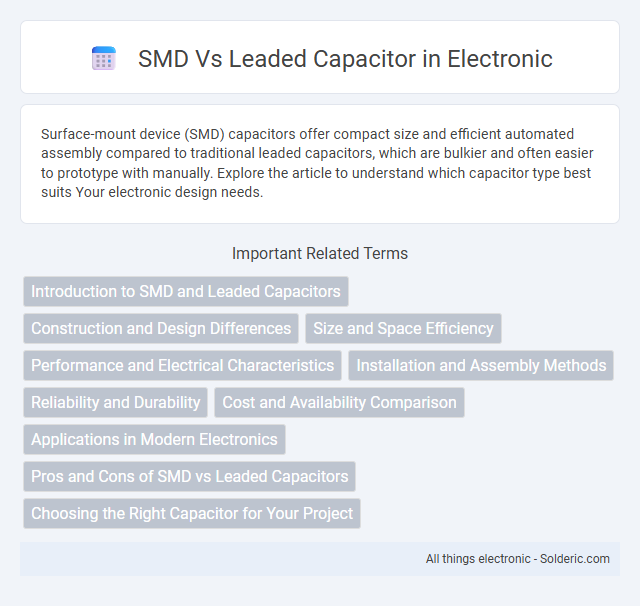Surface-mount device (SMD) capacitors offer compact size and efficient automated assembly compared to traditional leaded capacitors, which are bulkier and often easier to prototype with manually. Explore the article to understand which capacitor type best suits Your electronic design needs.
Comparison Table
| Feature | SMD Capacitor | Leaded Capacitor |
|---|---|---|
| Mounting Type | Surface Mount Technology (SMT) | Through-Hole Technology (THT) |
| Size | Compact, small footprint | Larger, bulkier |
| Assembly Speed | Faster, automated pick-and-place | Slower, manual or wave soldering |
| Performance | Low inductance, better high-frequency response | Higher inductance, less suitable for high frequencies |
| Repair and Replacement | Harder to repair manually | Easier to replace and test manually |
| Cost | Generally lower in mass production | Higher for automated assembly, but cheaper for prototyping |
| Applications | Modern electronics, compact and high-frequency circuits | Prototyping, power electronics, through-hole requirements |
Introduction to SMD and Leaded Capacitors
Surface-mount device (SMD) capacitors are compact, designed for automated assembly on printed circuit boards (PCBs), enabling high-density and lightweight electronic designs. Leaded capacitors, characterized by wire leads for through-hole mounting, are preferred in applications requiring higher mechanical strength and easier manual soldering. The choice between SMD and leaded capacitors depends on factors including circuit design, assembly methods, and environmental considerations.
Construction and Design Differences
SMD capacitors feature a compact, rectangular design with metal terminations on either end, enabling automated surface mounting directly onto PCB pads, while leaded capacitors have wire leads extending from the body for through-hole insertion. The construction of SMD capacitors typically involves multilayer ceramic layers or polymer films, offering a low-profile and lightweight form factor compared to the bulkier, often cylindrical body of leaded capacitors. You should choose based on your assembly method and space constraints, as SMD designs facilitate high-density circuits and automated placement, whereas leaded capacitors provide easier manual handling and robustness for prototyping or high-voltage applications.
Size and Space Efficiency
SMD capacitors are significantly smaller than leaded capacitors, making them ideal for compact electronic designs where space efficiency is critical. Their compact size allows for higher component density on PCBs, enabling more complex circuits within limited areas. Choosing SMD capacitors can optimize your device's layout by saving valuable board space while maintaining functionality.
Performance and Electrical Characteristics
SMD capacitors generally offer superior high-frequency performance and lower equivalent series resistance (ESR) compared to leaded capacitors, making them ideal for compact, high-speed circuit designs. Leaded capacitors tend to have higher inductance and ESR due to longer lead lengths, which can affect signal integrity and response time in sensitive applications. Your choice between SMD and leaded capacitors should consider the required electrical characteristics, including capacitance stability, tolerance, and frequency response, to optimize your circuit's overall performance.
Installation and Assembly Methods
Surface-mount device (SMD) capacitors are designed for automated pick-and-place machines, allowing for faster and more efficient installation on printed circuit boards (PCBs) with solder reflow processes. Leaded capacitors require manual insertion into through-hole PCB holes followed by wave soldering or hand soldering, making assembly slower and more labor-intensive. Your choice depends on production volume and assembly line capabilities, with SMD capacitors favored in high-speed automated manufacturing environments.
Reliability and Durability
SMD capacitors offer higher reliability and durability compared to leaded capacitors due to their smaller size and lack of leads, which reduces mechanical stress and improves performance under vibration and thermal cycling. Their surface-mount design enables better thermal dissipation and resistance to environmental factors, extending the lifespan of your electronic devices. Leaded capacitors, while still functional, are more prone to lead fatigue and mechanical failure, making SMD capacitors the preferred choice for long-term reliability.
Cost and Availability Comparison
SMD capacitors typically offer lower manufacturing costs due to automated assembly processes and their smaller size, making them widely available for mass production electronics. Leaded capacitors often have higher costs because of more manual handling and are generally preferred for prototyping or repairs where availability in smaller quantities matters. Your choice depends on the balance between budget constraints and the specific application requirements related to cost-effectiveness and component sourcing.
Applications in Modern Electronics
SMD capacitors dominate modern electronics due to their compact size and suitability for automated PCB assembly, making them ideal for smartphones, laptops, and wearable devices. Leaded capacitors remain preferred in high-reliability applications like aerospace and industrial machinery where manual soldering and durability under harsh conditions are critical. Your choice between SMD and leaded capacitors depends on the balance of miniaturization, manufacturing efficiency, and environmental robustness required for your specific application.
Pros and Cons of SMD vs Leaded Capacitors
SMD capacitors offer advantages such as smaller size, automated assembly compatibility, and better high-frequency performance, making them ideal for compact, modern electronics. Leaded capacitors provide easier manual handling, stronger mechanical stability, and are preferred in prototyping or repair scenarios due to through-hole mounting. Your choice depends on the application requirements for assembly efficiency, size constraints, and mechanical durability.
Choosing the Right Capacitor for Your Project
Selecting the right capacitor for your project depends heavily on factors such as size, frequency response, and mounting requirements. SMD capacitors offer compact size and excellent performance at high frequencies, making them ideal for modern, densely packed PCBs in consumer electronics. Leaded capacitors provide easier manual soldering and higher voltage ratings, which suits prototyping, repair work, and applications needing robust mechanical stability.
SMD vs leaded capacitor Infographic

 solderic.com
solderic.com